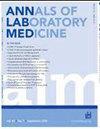用染色体微阵列鉴定的韩国人群纯合子区域:分布、频率和临床解释。
IF 3.9
2区 医学
Q1 MEDICAL LABORATORY TECHNOLOGY
引用次数: 0
摘要
基于单核苷酸多态性的染色体微阵列分析(CMA)可以检测纯合性(ROHs)区域,这可能与疾病有关;然而,有限的ROH数据,特别是在东亚,使临床解释复杂化。我们使用CMA对韩国人群中的ROH分布和频率进行了表征,并使用标准化标准强调了临床相关发现,包括可疑的单亲二体病(UPD)。方法我们分析了在韩国一家医疗中心接受产后CMA的1731名患者的ROHs。使用CytoScan Dx平台和染色体分析套件Dx检测长度≥3mb的ROHs。根据美国医学遗传学和基因组学学院的技术标准评估疑似UPD和血缘关系。结果共鉴定出3962例ROHs,其中76.7%的患者至少携带一种ROHs。常见的“热点”区域包括3p21.31p21.1(20.3%)、11p11.2(18.2%)、1q21.11 q21.3(17.7%)和1p33p32.3(12.0%)。几乎所有在bb0.1 %的患者中观察到的ROHs的中位大小< 5mb。ROH频率与染色体重组率呈负相关,与基因密度呈正相关。此外,1.2% (N = 21)的患者表现出提示UPD或血缘关系的ROH模式(13例疑似UPD在印迹染色体上,6例在非印迹染色体上,2例在血缘关系上);13例疑似UPD患者中有8例被诊断为印迹障碍,未检测到致病性拷贝数变异。结论韩国人群特异性的ROH数据通过最大限度地减少良性变异的过度解释风险,提高了临床解释,突出了可靠检测UPD和血缘的标准化标准的价值,并将ROH分析纳入常规CMA解释。本文章由计算机程序翻译,如有差异,请以英文原文为准。
Regions of Homozygosity Identified with a Chromosomal Microarray in a Korean Population: Distribution, Frequency, and Clinical Interpretation.
Background
Single nucleotide polymorphism-based chromosomal microarray analysis (CMA) can detect regions of homozygosity (ROHs), which may be associated with medical conditions; however, limited ROH data, especially in East Asians, complicates clinical interpretations. We characterized ROH distributions and frequencies in a Korean population using CMA, highlighting clinically relevant findings, including suspected uniparental disomy (UPD), using standardized criteria.
Methods
We analyzed ROHs in 1,731 individuals who underwent postnatal CMA at a Korean medical center. ROHs ≥ 3 Mb long were detected using the CytoScan Dx platform and Chromosome Analysis Suite Dx. Suspected UPD and consanguinity were assessed per the American College of Medical Genetics and Genomics technical standards.
Results
We identified 3,962 ROHs, with 76.7% of patients carrying at least one. Common "hotspot" regions included 3p21.31p21.1 (20.3%), 11p11.2 (18.2%), 1q21.1q21.3 (17.7%), and 1p33p32.3 (12.0%). Almost all ROHs observed in >1% of patients had a median size of <5 Mb. ROH frequencies correlated negatively with chromosomal recombination rates and positively with gene densities. Additionally, 1.2% (N = 21) of patients exhibited ROH patterns suggestive of UPD or consanguinity (13 suspected UPDs on imprinted chromosomes, 6 on non-imprinted chromosomes, and 2 consanguinities); 8 of 13 patients with suspected UPD were diagnosed as having imprinting disorders, with no pathogenic copy number variations detected.
Conclusions
Our population-specific ROH data for Koreans improve clinical interpretations by minimizing the risk of overinterpreting benign variants and highlight the value of standardized criteria for reliably detecting UPD and consanguinity and integrating ROH analysis into routine CMA interpretations.
求助全文
通过发布文献求助,成功后即可免费获取论文全文。
去求助
来源期刊

Annals of Laboratory Medicine
MEDICAL LABORATORY TECHNOLOGY-
CiteScore
8.30
自引率
12.20%
发文量
100
审稿时长
6-12 weeks
期刊介绍:
Annals of Laboratory Medicine is the official journal of Korean Society for Laboratory Medicine. The journal title has been recently changed from the Korean Journal of Laboratory Medicine (ISSN, 1598-6535) from the January issue of 2012. The JCR 2017 Impact factor of Ann Lab Med was 1.916.
 求助内容:
求助内容: 应助结果提醒方式:
应助结果提醒方式:


